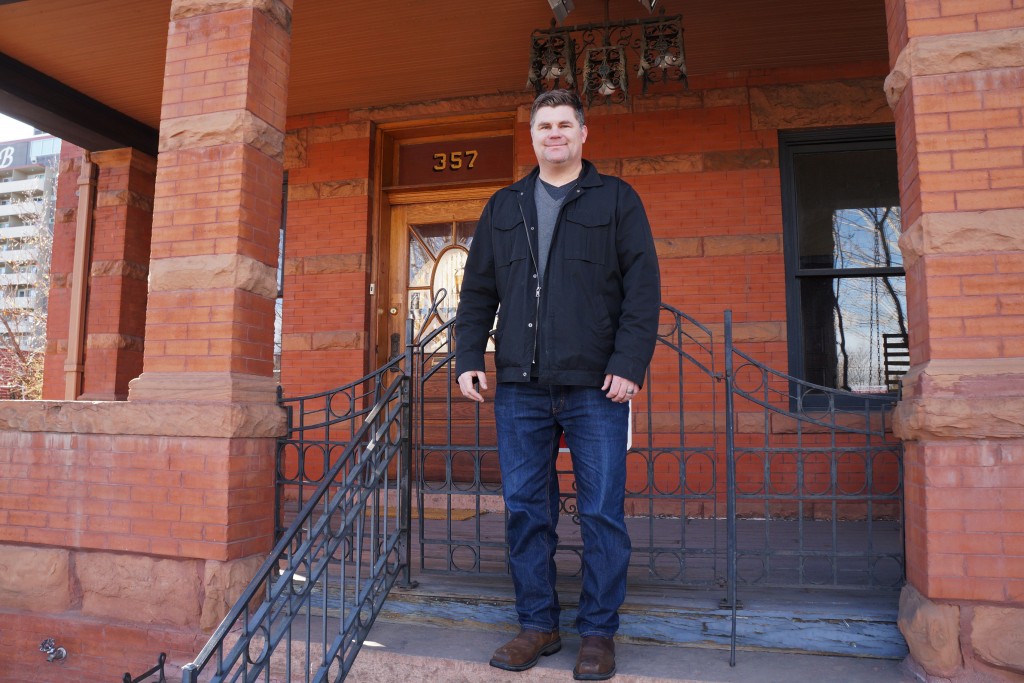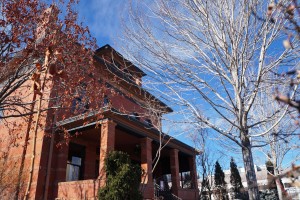
Derek Kuykendall’s nonprofit is fixing up a Broadway house for use as a group home. Photos by Amy DiPierro.
A Denver nonprofit is turning one of the last 19th century mansions still standing on Broadway into a group home for kids that might otherwise end up living on the street.
Providence Network will begin refurbishing the property at 357 N. Broadway, which it plans to call Silver Lining House, in late winter. The three-floor Italian Renaissance-style building will be the nonprofit’s fifth housing project.
Executive Director Derek Kuykendall said the new group home continues Providence Network’s tradition of rehabbing turn-of-the-century real estate. The nonprofit currently operates four homes, three built before 1905.
“We like the idea of turning something old and in disrepair into something beautiful,” he said. “It parallels what we try to do with people’s lives.”
The nonprofit, started in 1988, buys houses and converts them into apartments for people recovering from substance abuse and homelessness. Residents live with counselors, who help them share household chores, stay sober and straighten their finances.
Kuykendall said buying 100-year-old properties also signals to residents that Providence Network is dedicated to keeping people like them – who might otherwise be unable to afford Denver – in the city for the next 100 years.
More concretely, the financial bedrock of the nonprofit is property ownership, Kuykendall said.
Providence Network has never applied for a state grant, he said, in part because it almost always fundraises enough to pay for its properties in cash. It then borrows against them for one-time expenses.
The nonprofit also generates rental income. Residents can live in entry-level housing for up to two years rent-free before they have the option to rent apartments. Rent accounts for about 30 percent of Providence Network’s annual income, which Kuykendall said encourages residents to stay with the nonprofit.
“A lot of people would see a pool or a gym as an amenity,” he said. “Our residents see the program as a way not just to stay healthy for themselves, but to help the next generation.”
The nonprofit reported $1.17 million in total revenue in 2014.
Kuykendall said Providence Network’s in-house mental health and addiction treatment model also stands out in a city where most transitional housing programs don’t include such services. He’s extending that system to homeless young people ages 18 to 25, who have aged out of childhood programs but are intimidated by adult shelters.
Providence Network’s other houses also group residents by common experiences. Joy House is for women and children escaping domestic violence. Meanwhile graduates of the nonprofit’s two-year program live together in Clausen House in Curtis Park and Victory House in Five Points.
The nonprofit acquired its first home around the time of its founding in 1988. That site, an 18-bedroom Moorish style mansion in Capitol Hill built for Denver businessman Hal Sayre, dates back to 1901.
The property that will become Silver Lining House is one of the last relics of a time when the street was a residential stretch through Denver. Built by Denver contractor Joseph A. Osner to be his family’s residence in 1893, the red brick and sandstone house once counted Denver personalities like Rocky Mountain News founder John L. Dailey among its neighbors. It includes a carriage house in addition to the three-floor mansion.
357 Broadway stayed in the Osner family through the 1980s, when it was purchased by Jim Chandler to be the storefront for his shop, Gateway Antiques. But when Chandler retired, the semi-abandoned house fell into disrepair. It has since tested positive for methamphetamine; as recently as this fall, Providence Network was checking that the premise was meth-free.
Providence Network bought the property for $1.1 million in September from Chandler, according to Denver property records. Kuykendall estimates the renovation will cost an additional $700,000.
The house gets its name from Silver Lining Foundation, a family foundation based in Denver.
Architect Chad Holtzinger of Shopworks, who has also worked with the nonprofits Mi Casa and Urban Peak, will help design elements of the renovation. Providence Network is currently seeking a general contractor, Kuykendall said and will have space for a maximum of 18 residents and six live-in staff.
The city of Denver approved Providence Network’s petition to transform the Baker residence into a group home this September; in November, a developer appealing that decision dropped his case. Providence Network plans to open the home by next December.
Over the next three years, Providence Network is hoping to purchase another property to make into for-rent housing, budgeting $4 million across Silver Lining House and this next home.
Providence Network’s other homes:
– Providence House is the first site owned and operated by Providence Network. According to the nonprofit Historic Denver, the house is a Moorish style mansion in Capitol Hill built for Denver businessman Hal Sayre in 1901.
– Joy House is Providence Network’s home for women and children escaping domestic abuse.
– Victory House is the nonprofit’s first for-rent housing project. It is located in a three-story brick-and-stone building constructed by the architect John H. Barnes in Five Points as a home for low wage laborers in 1892, according to History Colorado.
– Clausen House is another for-rent housing site. It was constructed in 1904 from a design by William Cowe, an architect known for building single-family houses and apartments. The 22-apartment building was remodeled in 1996 for $950,000, according to the architecture firm Blue Sky Studio.

Derek Kuykendall’s nonprofit is fixing up a Broadway house for use as a group home. Photos by Amy DiPierro.
A Denver nonprofit is turning one of the last 19th century mansions still standing on Broadway into a group home for kids that might otherwise end up living on the street.
Providence Network will begin refurbishing the property at 357 N. Broadway, which it plans to call Silver Lining House, in late winter. The three-floor Italian Renaissance-style building will be the nonprofit’s fifth housing project.
Executive Director Derek Kuykendall said the new group home continues Providence Network’s tradition of rehabbing turn-of-the-century real estate. The nonprofit currently operates four homes, three built before 1905.
“We like the idea of turning something old and in disrepair into something beautiful,” he said. “It parallels what we try to do with people’s lives.”
The nonprofit, started in 1988, buys houses and converts them into apartments for people recovering from substance abuse and homelessness. Residents live with counselors, who help them share household chores, stay sober and straighten their finances.
Kuykendall said buying 100-year-old properties also signals to residents that Providence Network is dedicated to keeping people like them – who might otherwise be unable to afford Denver – in the city for the next 100 years.
More concretely, the financial bedrock of the nonprofit is property ownership, Kuykendall said.
Providence Network has never applied for a state grant, he said, in part because it almost always fundraises enough to pay for its properties in cash. It then borrows against them for one-time expenses.
The nonprofit also generates rental income. Residents can live in entry-level housing for up to two years rent-free before they have the option to rent apartments. Rent accounts for about 30 percent of Providence Network’s annual income, which Kuykendall said encourages residents to stay with the nonprofit.
“A lot of people would see a pool or a gym as an amenity,” he said. “Our residents see the program as a way not just to stay healthy for themselves, but to help the next generation.”
The nonprofit reported $1.17 million in total revenue in 2014.
Kuykendall said Providence Network’s in-house mental health and addiction treatment model also stands out in a city where most transitional housing programs don’t include such services. He’s extending that system to homeless young people ages 18 to 25, who have aged out of childhood programs but are intimidated by adult shelters.
Providence Network’s other houses also group residents by common experiences. Joy House is for women and children escaping domestic violence. Meanwhile graduates of the nonprofit’s two-year program live together in Clausen House in Curtis Park and Victory House in Five Points.
The nonprofit acquired its first home around the time of its founding in 1988. That site, an 18-bedroom Moorish style mansion in Capitol Hill built for Denver businessman Hal Sayre, dates back to 1901.
The property that will become Silver Lining House is one of the last relics of a time when the street was a residential stretch through Denver. Built by Denver contractor Joseph A. Osner to be his family’s residence in 1893, the red brick and sandstone house once counted Denver personalities like Rocky Mountain News founder John L. Dailey among its neighbors. It includes a carriage house in addition to the three-floor mansion.
357 Broadway stayed in the Osner family through the 1980s, when it was purchased by Jim Chandler to be the storefront for his shop, Gateway Antiques. But when Chandler retired, the semi-abandoned house fell into disrepair. It has since tested positive for methamphetamine; as recently as this fall, Providence Network was checking that the premise was meth-free.
Providence Network bought the property for $1.1 million in September from Chandler, according to Denver property records. Kuykendall estimates the renovation will cost an additional $700,000.
The house gets its name from Silver Lining Foundation, a family foundation based in Denver.
Architect Chad Holtzinger of Shopworks, who has also worked with the nonprofits Mi Casa and Urban Peak, will help design elements of the renovation. Providence Network is currently seeking a general contractor, Kuykendall said and will have space for a maximum of 18 residents and six live-in staff.
The city of Denver approved Providence Network’s petition to transform the Baker residence into a group home this September; in November, a developer appealing that decision dropped his case. Providence Network plans to open the home by next December.
Over the next three years, Providence Network is hoping to purchase another property to make into for-rent housing, budgeting $4 million across Silver Lining House and this next home.
Providence Network’s other homes:
– Providence House is the first site owned and operated by Providence Network. According to the nonprofit Historic Denver, the house is a Moorish style mansion in Capitol Hill built for Denver businessman Hal Sayre in 1901.
– Joy House is Providence Network’s home for women and children escaping domestic abuse.
– Victory House is the nonprofit’s first for-rent housing project. It is located in a three-story brick-and-stone building constructed by the architect John H. Barnes in Five Points as a home for low wage laborers in 1892, according to History Colorado.
– Clausen House is another for-rent housing site. It was constructed in 1904 from a design by William Cowe, an architect known for building single-family houses and apartments. The 22-apartment building was remodeled in 1996 for $950,000, according to the architecture firm Blue Sky Studio.



Leave a Reply